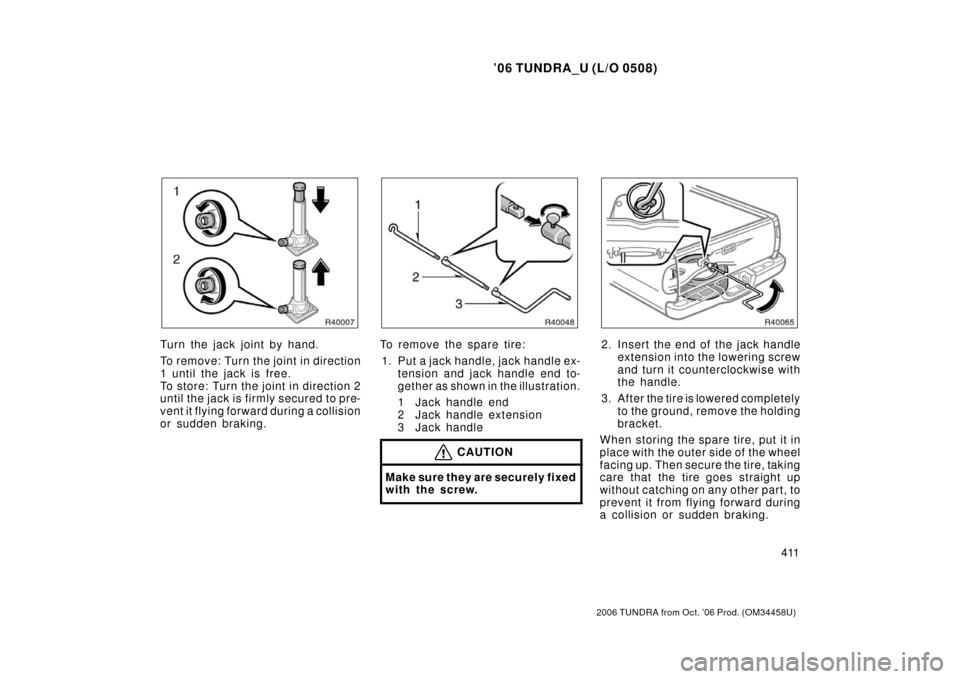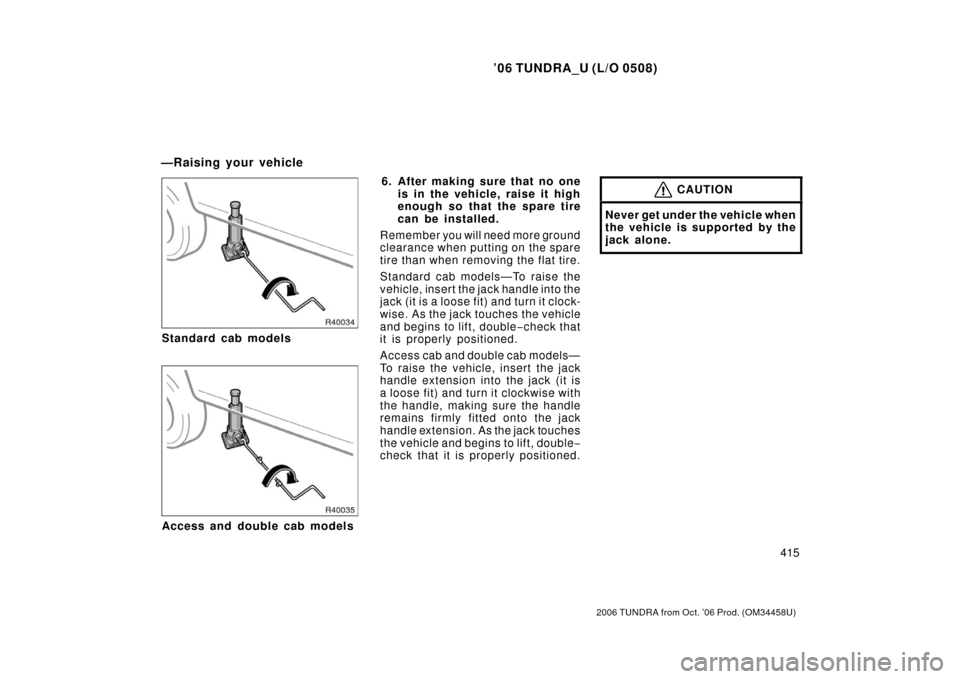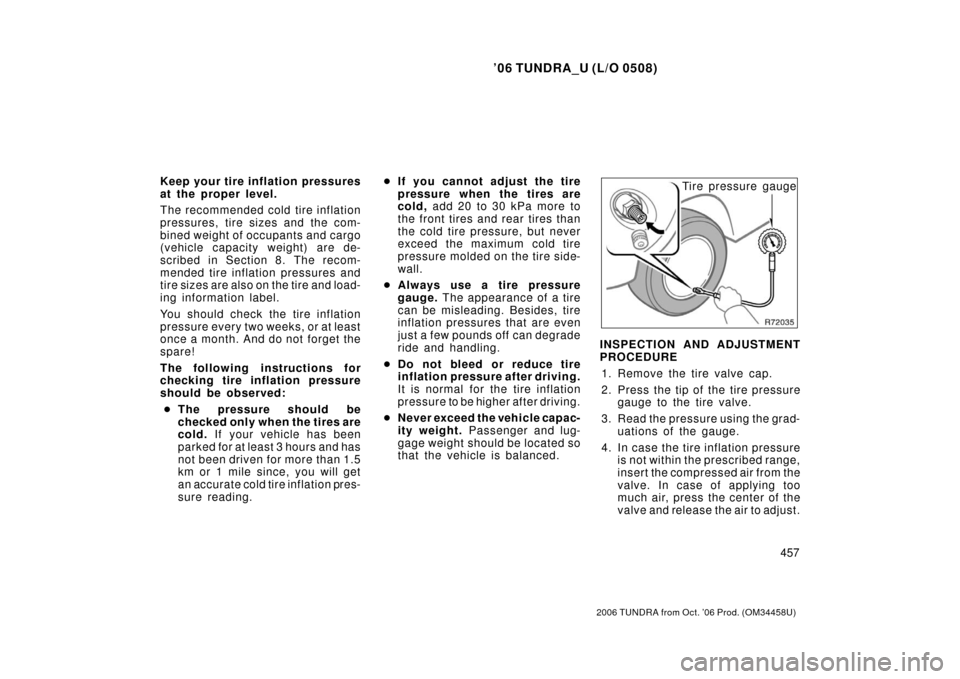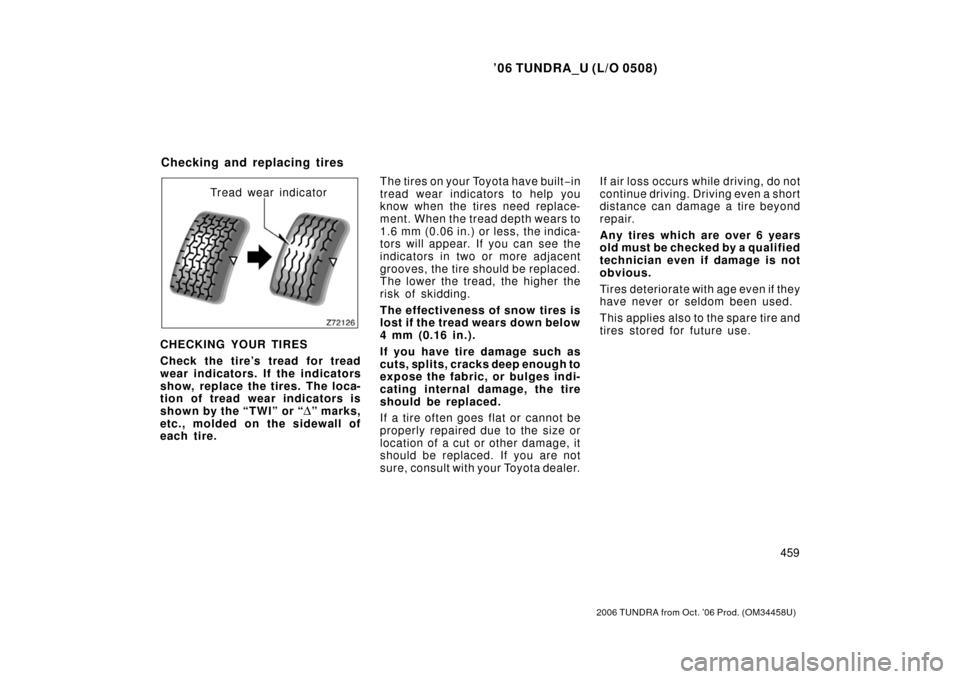Page 423 of 527

’06 TUNDRA_U (L/O 0508)
411
2006 TUNDRA from Oct. ’06 Prod. (OM 34458U)
Turn the jack joint by hand.
To rem ov e: Tur n the joint in direction
1 until the jack is free.
To store: Turn the joint in direction 2
until the jack is fi rmly secured to pre-
vent it flying forward during a collision
or sudden braking.To remove the spare tire:
1. Put a jack handle, jack handle ex- tension and jack handle end to-
gether as shown in the illustration.
1 Jack handle end
2 Jack handle extension
3 Jack handle
CAUTION
Make sure they are securely fixed
with the screw.
2. Insert the end of the jack handle
extension into the lowering screw
and turn it counterclockwise with
the handle.
3. After the tire is lowered completely to the ground, remove the holding
bracket.
When storing the spare tire, put it in
place with the outer side of the wheel
facing up. Then secure the tire, taking
care that the tire goes straight up
without catching on any other part, to
prevent it from flying forward during
a collision or sudden braking.
Page 427 of 527

’06 TUNDRA_U (L/O 0508)
415
2006 TUNDRA from Oct. ’06 Prod. (OM 34458U)
Standard cab models
Access and double cab models 6. After making sure that no one
is in the vehicle, raise it high
enough so that the spare tire
can be installed.
Remember you will need more ground
clearance when putting on the spare
tire than when removing the flat tire.
Standard cab models—To raise the
vehicle, insert the jack handle into the
jack (it is a loose fit) and turn it clock-
wise. As the jack touches the vehicle
and begins to lift, double− check that
it is properly positioned.
Access cab and double cab models—
To raise the vehicl e, insert the jack
handle extension into the jack (it is
a loose fit) and turn it clockwise with
the handle, making sure the handle
remains firmly fitted onto the jack
handle extension. As the jack touches
the vehicle and begins to lift, double −
check that it is properly positioned.
CAUTION
Never get under the vehicle when
the vehicle is supported by the
jack alone.
—Raising your vehicle
Page 428 of 527
’06 TUNDRA_U (L/O 0508)
416
2006 TUNDRA from Oct. ’06 Prod. (OM 34458U)
7. Remove the wheel nuts and
change tires.
Lift the flat tire straight off and put it
aside.
Roll the spare wheel into position and
align the holes in the wheel with the
bolts. Then lift up the wheel and get
at least the top bolt started through
its hole. Wiggle the tire and press it
back over the other bolts.Before putting on wheels, remove any
corrosion on the mounting surfaces
with a wire brush or such. Installation
of wheels without good metal− to−met-
al contact at the mounting surface can
cause wheel nuts to loosen and
eventually cause a wheel to come off
while driving.8. Reinstall all the wheel nuts fin- ger tight.
Reinstall the wheel nuts (tapered end
inward) and tighten them as much as
you can by hand. Press back on the
tire back and see if you can tighten
them more.
—Changing wheels —Reinstalling wheel nuts
Page 431 of 527

’06 TUNDRA_U (L/O 0508)
419
2006 TUNDRA from Oct. ’06 Prod. (OM 34458U)
CAUTION
�Take due care in handling the
ornament to avoid unexpected
personal injury.
� Do not attach a heavily dam-
aged plastic wheel ornament.
It may fly off the wheel and
cause accidents while the ve-
hicle is moving.
11. Check the air pressure of the re-
placed tire.
Adjust the air pressu re to the specifi-
cation designated in Section 8. If the
pressure is lower, drive slowly to the
nearest service station and fill to the
correct pressure.
Do not forget to reinstall the tire infla-
tion valve cap as dirt and moisture
could get into th e valve core and
possibly cause air leakage. If the cap
is missing, have a new one put on as
soon as possible.
12.Restow all the tools, jack and flat tire securely.
With a spare tire of the same wheel
type as the installed tires—
As soon after changing wheels as
possible, tighten the wheel nuts to the
torque specified in Section 8 with a
torque wrench. Have a technician re-
pair the flat tire.
With a spare tire of different wheel
type from the installed tires— As soon after changing wheels as
possible, tighten the wheel nuts to the
torque specified in Section 8 with a
torque wrench. Have a technician re-
pair the flat tire and replace the spare
tire with it.
CAUTION
Before driving, make sure all the
tools, jack and flat tire are se-
curely in place in their storage
location to reduce the possibility
of personal injury during a colli-
sion or sudden braking.
Initial adjustment of the tire pres-
sure warning system is necessary
after you have rotated your tires.
See “Tire pressure warning sys-
tem” in Section 1�7.
—After changing wheels
Page 469 of 527

’06 TUNDRA_U (L/O 0508)
457
2006 TUNDRA from Oct. ’06 Prod. (OM 34458U)
Keep your tire inflation pressures
at the proper level.
The recommended cold tire inflation
pressures, tire sizes and the com-
bined weight of occupants and cargo
(vehicle capacity weight) are de-
scribed in Section 8. The recom-
mended tire inflation pressures and
tire sizes are also on the tire and load-
ing information label.
You should check the tire inflation
pressure every two weeks, or at least
once a month. And do not forget the
spare!
The following instructions for
checking tire inflation pressure
should be observed:
� The pressure s hould be
checked only when the tires are
cold. If your vehicle has been
parked for at least 3 hours and has
not been driven for more than 1.5
km or 1 mile since, you will get
an accurate cold tire inflation pres-
sure reading. �
If you cannot adjust the tire
pressure when the tires are
cold, add 20 to 30 kPa more to
the front tires and rear tires than
the cold tire pr essure, but never
exceed the maximum cold tire
pressure molded on the tire side-
wall.
� Always use a tire pressure
gauge. The appearance of a tire
can be misleading. Besides, tire
inflation pressures that are even
just a few pounds off can degrade
ride and handling.
� Do not bleed or reduce tire
inflation pressure after driving.
It is normal for the tire inflation
pressure to be higher after driving.
� Never exceed the vehicle capac-
ity weight. Passenger and lug-
gage weight should be located so
that the vehicle is balanced.Tire pressure gauge
INSPECTION AND ADJUSTMENT
PROCEDURE 1. Remove the tire valve cap.
2. Press the tip of the tire pressure gauge to the tire valve.
3. Read the pressure using the grad- uations of the gauge.
4. In case the tire inflation pressure
is not within the prescribed range,
insert the compressed air from the
valve. In case of applying too
much air, press the center of the
valve and release the air to adjust.
Page 471 of 527

’06 TUNDRA_U (L/O 0508)
459
2006 TUNDRA from Oct. ’06 Prod. (OM 34458U)
Tread wear indicator
CHECKING YOUR TIRES
Check the tire’s tread for tread
wear indicators. If the indicators
show, replace the tires. The loca-
tion of tread wear indicators is
shown by the “TWI” or “
Δ” marks,
etc., molded on the sidewall of
each tire. The tires on your Toyota have built
−in
tread wear indicators to help you
know when the tires need replace-
ment. When the tread depth wears to
1.6 mm (0.06 in.) or less, the indica-
tors will appear. If you can see the
indicators in two or more adjacent
grooves, the tire should be replaced.
The lower the tread, the higher the
risk of skidding.
The effectiveness of snow tires is
lost if the tread wears down below
4 mm (0.16 in.).
If you have tire damage such as
cuts, splits, cracks deep e nough to
expose the fabric, or bulges indi-
cating internal damage, the tire
should be repl aced.
If a tire often goes flat or cannot be
properly repaired due to the size or
location of a cut or other damage, it
should be replaced. If you are not
sure, consult with your Toyota dealer. If air loss occurs while driving, do not
continue driving. Driving even a short
distance can damage a tire beyond
repair.
An y ti res wh i ch are over 6 years
old must be checked by a qualified
technician even if damage is not
obvious.
Tires deteriorate with age even if they
have never or seldom been used.
This applies also to the spare tire and
tires stored for future use.
Checking and replacing tires
Page 473 of 527
’06 TUNDRA_U (L/O 0508)
461
2006 TUNDRA from Oct. ’06 Prod. (OM 34458U)
Initial adjustment of the tire pres-
sure warning system is necessary
after you have rotated your tires.
See “Tire pressure warning sys-
tem” in Section 1�7.
With a spare tire of the same
wheel type as the installed tiresWith a spare tire of different
wheel type from the installed
tires
Rotating tires
Page 503 of 527
’06 TUNDRA_U (L/O 0508)
491
2006 TUNDRA from Oct. ’06 Prod. (OM 34458U)
Tire size, cold tire inflation pressure and wheel size:
Standard and access cab models
Ti r e siz e
Tire inflation pressure kPa (kgf/cm2 or bar, psi)Wheel sizeFrontRearSpare∗ 1
P245/70R16 106S200 (2.0, 29)240 (2.4, 35)240 (2.4, 35)7J or 7JJ �16
P265/70R16 111S180 (1.8, 26)∗
2
200 (2.0, 29)∗3200 (2.0, 29)∗2
210 (2.1, 30)∗3200 (2.0, 29)∗2
210 (2.1, 30)∗37J or 7JJ �16
P265/65R17 110S200 (2.0, 29)220 (2.2, 32)220 (2.2, 32)71/2JJ �17
∗
1: If you affix the spare tire to a front position, please make sure to adjust the tire to the correct inflation pressure
as soon as possible.
∗ 2: Vehicles without off −road package∗
3: Vehicles with off −road package
Tires